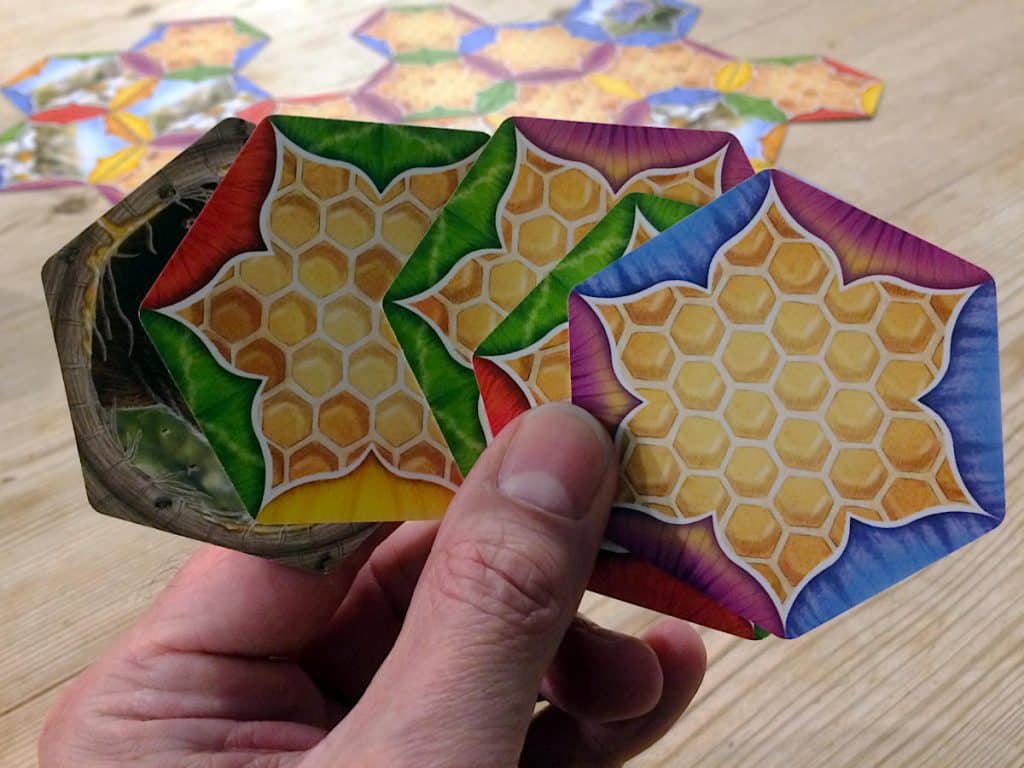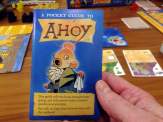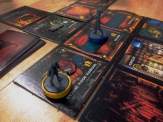| Release Date: 2018 | Players: 2-5 |
| Designer: Jeffery Beck | Length: 15-45 minutes |
| Artist: Apryl Stott, David Bock | Age: 8+ |
| Publisher: Grandpa Beck’s Games | Complexity: 1.5 / 5 |
| Plastic (by weight): unknown | Air (by volume): unknown |
Listen to the Audio Version
Intro Music: Bomber (Sting) by Riot (https://www.
Sound Effects: bbc.co.uk – © copyright 2025 BBC
Music I use: Bensound
License code: TGVXMB83NMTKHFFN
Artist: : Aventure
Music: https://www.
License code: STXBG0K2SL8ZYS9I
Artist: : Aventure
Building the Hive
At the heart of The Bears and the Bees is the shared hive. It starts with a single queen bee tile from which the colony grows. Everyone has a number of tiles in their hand, and you need to place them in such a way that the coloured edges match. If you can get rid of all of your tiles first, you win. The problem is, whenever none of the hexes in your hand have somewhere to go, you have to draw a new tile and pass the turn to the next player.

Get yourself a wooden Tabletop Games Blog dice tray.
Each tray is the perfect size to roll your dice, and with the soft mat, it’s really quiet, while the wooden frame makes it wonderfully sturdy.
So as players add their tiles to the hive, the puzzle grows, either giving other players more options for their tiles or potentially blocking the only space they needed. That’s where the game truly comes alive. It’s a little like Carcassonne in that you need to find the perfect place for your tile, but others might be blocking that location when they place their tile. The main difference is, you always have a place to put your tile in Carcassonne, with some rare exceptions, while in The Bears and the Bees, you are more likely to have to draw another tile to add to your hand and pass your turn. Matching colours to place tiles can be surprisingly tricky. You’d think a growing hive increases your options, and while you can sometimes set up a perfect move for yourself, most of the time, others block you.
The shared hive also replicates nature. The tile-placement rules keep the layout organic and varied. Watching it expand feels satisfying, and the result looks amazing on the table. It really does feel and look like a busy beehive in a field of flowers. The only difference is that everyone is competing for space, which is not what honeybees do in nature.

Special Visitors and Colourful Bees
In addition to standard tiles, there are special ones that change the rhythm of play.
Worker tiles allow you to choose an opponent who has to draw an extra tile, which will slow their progress. Flower tiles work similarly, making all other players draw a card at once. Drone tiles, on the other hand, allow you to take another turn. That’s a huge advantage.
There are also bear tiles, which represent the bear from Aesop‘s fable. They cannot touch the queen but must connect to a honey edge, which isn’t always easy to achieve. Yet, if you can make it happen, you can give one of your tiles to another player. That can be as strategic as a normal tile placement on the board.
These special tiles add just enough variety and interest to lift the gameplay experience of The Bears and the Bees above other tile-laying games. They also give the hive a touch of personality, turning each game into its own mini story. The mix of tile types and the choices of the players ensures that no two hives will ever grow in quite the same way.
Visually, The Bears and the Bees is bright and inviting. The queen tile, for example, with its all-honey edges, still stands out at the end of the game. Even though the tiles are cards, they are very sturdy. The clear, warm illustrations help distinguish the different types.
Yet, some of the colours are a bit too similar. I’m slightly colour-blind, but even people with perfect colour vision will find it hard to differentiate similar shades, especially once the hive has grown and there is a jumble of colours.

A Game with Buzz
I have always loved tile-laying games. There is a certain joy in seeing a pattern emerge on the table, and here that joy is amplified by the interplay of cooperation and competition. The hive grows, players adapt, and a single well-timed placement can feel like a small triumph.
With The Bears and the Bees, Grandpa Beck’s Games have continued their track record of creating accessible yet strategic titles. I have previously reviewed Skull King, for example, which is from the same publisher and hits the same spot for a clever trick-taking game, as The Bears and the Bees does for tile-laying games.
It’s really easy to learn, and while each turn is theoretically quite simple, foresight is essential. You have to keep an eye on what everyone else is doing, while considering your own potential moves. Despite this, the game flows really quickly. The game can be played with people from a wide range of ages and experience levels. I find it a rare example of a game that works equally well as a relaxed family game, as well as a light tactical game that players who love thinkier titles will really enjoy too.
For someone like me, who has a deep fondness for tile-laying puzzles, it is the kind of game that should come to the table regularly and is always welcome at any board game night, whether with family or friends.
This blog is free for everyone, but if you'd like to support it, here are some options.
Useful Links
- The Bears and the Bees: https://www.
grandpabecksgames. com/ products/ the-bears-and-the-bees - Rulebook: https://cdn.
shopify. com/ s/ files/ 1/ 0565/ 3230/ 4053/ files/ bb_ rulebook_ optimized. pdf? v= 1652992513 - Grandpa Beck’s Games: https://www.
grandpabecksgames. com - BGG listing: https://boardgamegeek.
com/ boardgame/ 257372/ the-bears-and-the-bees - Skull King review: https://tabletopgamesblog.
com/ 2020/ 01/ 04/ skull-king-saturday-review/
Videos
Transparency Facts
I feel that this review reflects my own, independent and honest opinion, but the facts below allow you to decide whether you think that I was influenced in any way. Please also read my Ethics Statement for more information.- I played a friend's copy of the game.
- At the time of writing, I have not received financial support from the publisher or anyone working on their behalf.
Audio Version
Intro Music: Bomber (Sting) by Riot (https://www.
Sound Effects: bbc.co.uk – © copyright 2025 BBC
Music I use: Bensound
License code: TGVXMB83NMTKHFFN
Artist: : Aventure
Music: https://www.
License code: STXBG0K2SL8ZYS9I
Artist: : Aventure
Playlist
These are the songs I listened to while I was writing this review:





